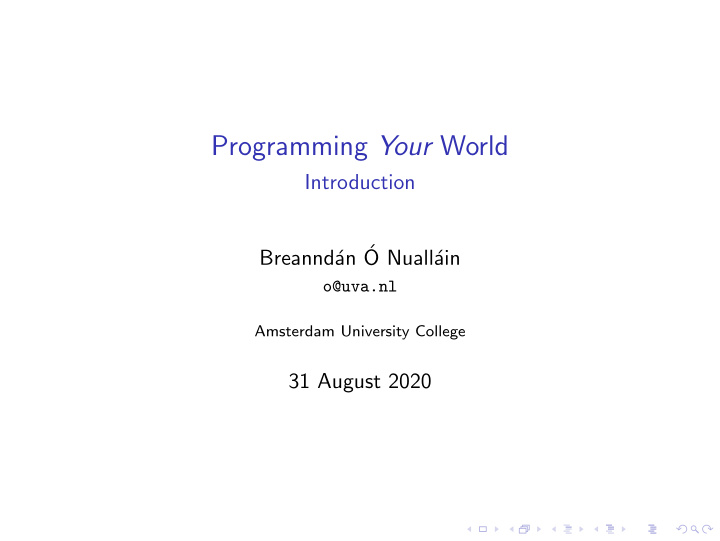



Programming Your World Introduction an ´ Breannd´ O Nuall´ ain o@uva.nl Amsterdam University College 31 August 2020
The programme for today 1. Getting acquainted
The programme for today 1. Getting acquainted 2. Getting oriented
The programme for today 1. Getting acquainted 2. Getting oriented 3. Getting informed
The programme for today 1. Getting acquainted 2. Getting oriented 3. Getting informed 4. Getting tooled up
The programme for today 1. Getting acquainted 2. Getting oriented 3. Getting informed 4. Getting tooled up 5. Getting started. . .
The source http://pyw.auc-computing.nl/ https://canvas.uva.nl
Course Manual http://pyw.auc-computing.nl/course-manual.html
Why study computing? ◮ to program
Why study computing? ◮ to program ◮ to become empowered
Why study computing? ◮ to program ◮ to become empowered ◮ to get organised
Why study computing? ◮ to program ◮ to become empowered ◮ to get organised ◮ to understand the digital world around us
Why study computing? ◮ to program ◮ to become empowered ◮ to get organised ◮ to understand the digital world around us ◮ to communicate with ICT professionals
Why study computing? ◮ to program ◮ to become empowered ◮ to get organised ◮ to understand the digital world around us ◮ to communicate with ICT professionals ◮ to be more informed citizens and leaders
Why study computing? ◮ to program ◮ to become empowered ◮ to get organised ◮ to understand the digital world around us ◮ to communicate with ICT professionals ◮ to be more informed citizens and leaders ◮ to develop an algorithmic way of thinking
Algorithmic Thinking
Applications ◮ Your world ◮ Science
Applications ◮ Your world ◮ agenda, assignments ◮ web, email, photos, music ◮ social networks ◮ Science
Applications ◮ Your world ◮ agenda, assignments ◮ web, email, photos, music ◮ social networks ◮ Science ◮ complex networks ◮ transmission of disease (influenza, HIV) ◮ levels: population, individual, protein interaction
Brain networks
Drug-Drug Interactions Mechanisms of drug combinations: interaction and network perspectives Jia Jia, et al. Nature Reviews Drug Discovery 2009
Drugs & Target Proteins From Structural controllability of unidirectional bipartite networks, Jose C. Nacher & Tatsuya Akutsu, Nature Scientific Reports, 2013
Hierarchical Networks ◮ De Grote Griepmeting
Social Networks
Derived graphs from a social network
Applications AUC’s social network “Things Happen Faster in the Bubble” News Feeds Collect your own news Processing natural language NLTK examples in Python Machine Learning Scikit Learn examples
Programming languages ◮ Most popular programming languages ◮ Racket, Python, Javascript ◮ Learning versus Using. ◮ Designing versus tinkering. ◮ Necessary versus unnecessary complexity. ◮ Large programs.
Racket ◮ Racket ◮ a kind of Scheme, a kind of Lisp ◮ Paradigm: “Multi-paradigm: Functional, Procedural, Modular, Object-oriented, Reflective, Meta. . . ” ◮ Pedagogical, layered, graded languages. ◮ “Teach Scheme, reach Java” ◮ “systematic design” approach to problem solving.
Sources To get us started. . . ◮ The Racket programming environment ◮ The How to Design Programs book. (2nd edition)
Python ◮ Python, documentation ◮ Invention ◮ Ethos: scripting, prototyping, not so much programming as gluing. ◮ Many libraries ◮ Zen of Python ◮ 2nd language ◮ Used in other courses at AUC
Down to business. . . ◮ Class interaction ◮ Experimental inquiry, whatiffery ◮ Weekly 3 contact hours, 7 self-study hours, mostly programming. ◮ Time keeping, time use, ready to go: browser & DrRacket open. ◮ Attendance & punctuality. Late = absent. ◮ Laptop & telephone do’s and don’ts. ◮ Working sessions ◮ Assignments and evaluation. ◮ Take DrRacket for a test drive.
Recommend
More recommend